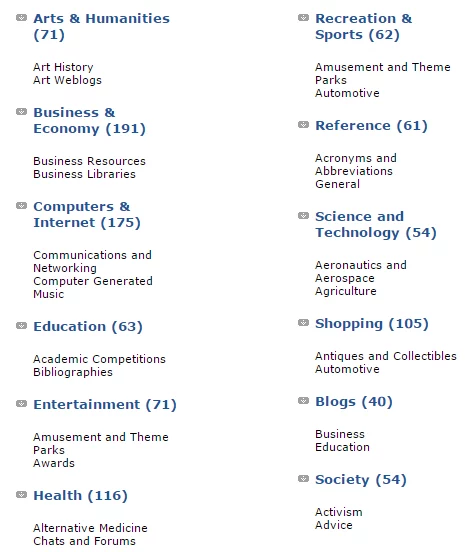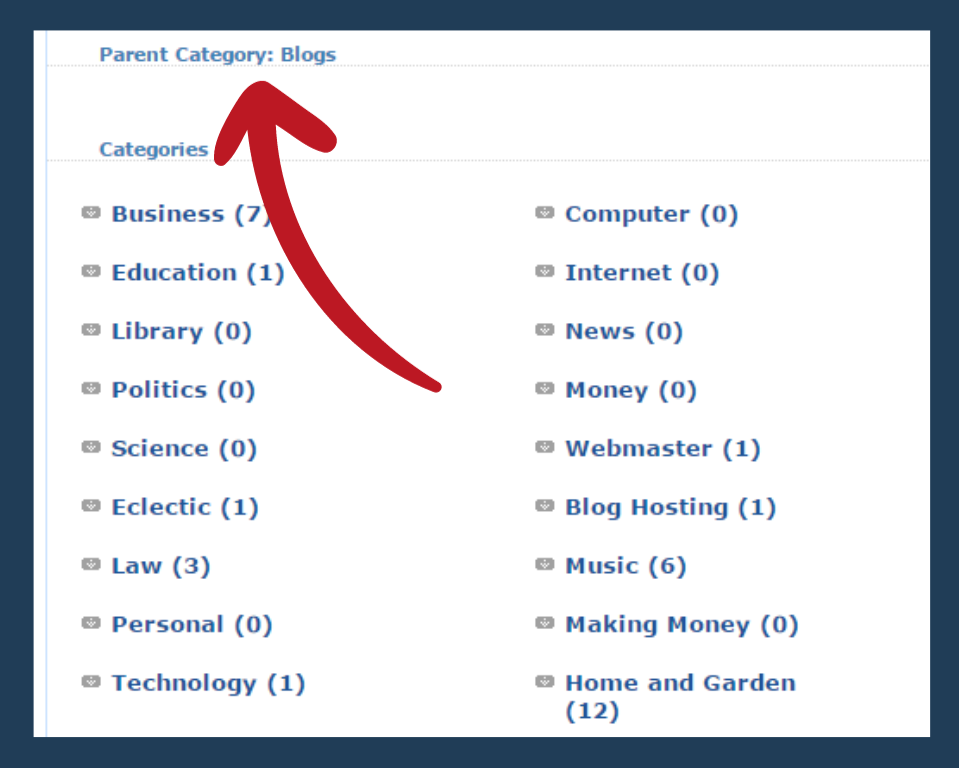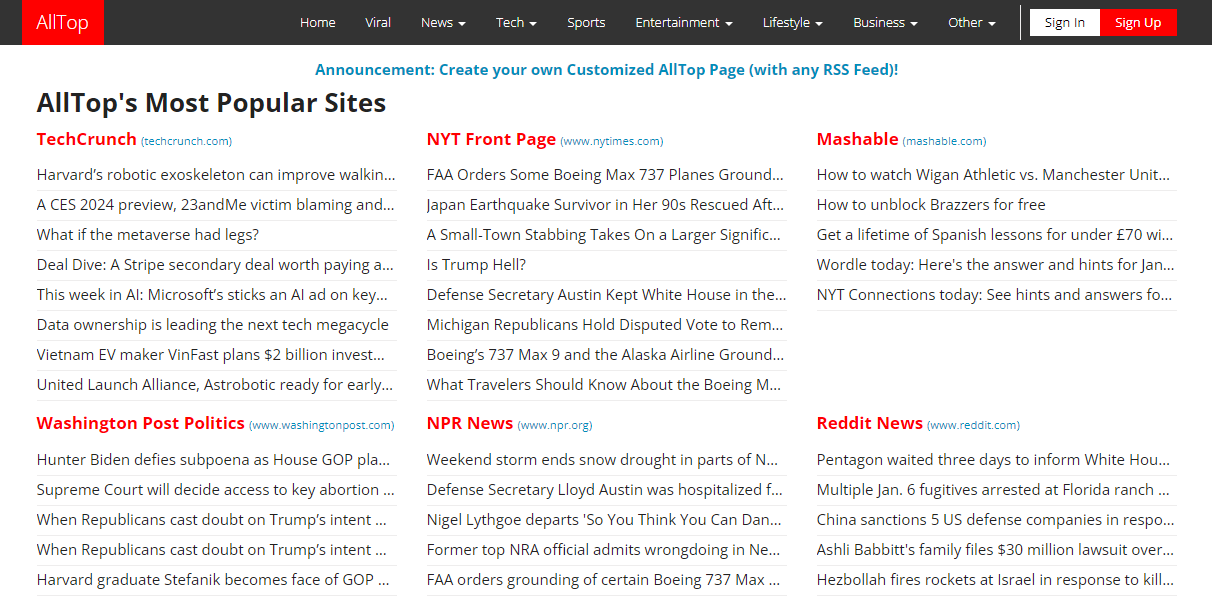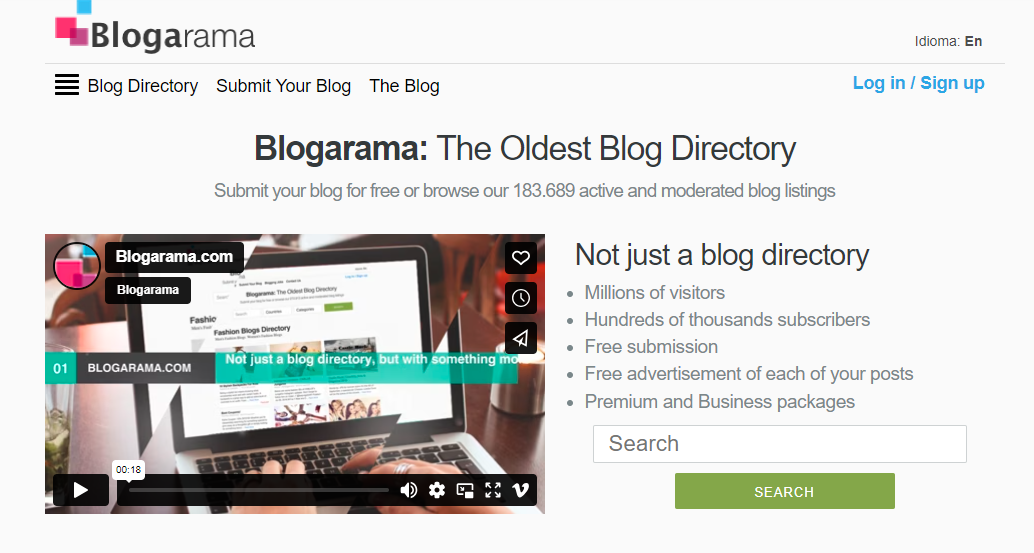What Are Blog Submission Directories In SEO?

Before we start discussing blog submission directories for SEO, let’s first briefly understand what a directory is in the first place.
Directories serve as online platforms designed for housing businesses and their related information. Imagine it as the act of incorporating a website into a web directory. Similar to how a telephone directory allows you to locate a specific number by searching for a name, a directory facilitates the discovery of businesses and details about the company.
On-page SEO tactics include adding trending keywords in the right places, creating original images, linking to resourceful websites, etc. However, blog submission directories in SEO are an off-page tactic, where you work outside your blog page.
To understand this better, you can check our on-page and off-page SEO guide.
In this article, we’ll discuss what blog submission directories for SEO are, how they work, and how you can increase your domain authority (DA) using one!
What Are Directory Submissions?
Directory submission involves the practice of sharing your website URL and details on the web within a specific category of a directory. It’s a strategy that contributes to enhancing your SEO link-building efforts.
When submitting your website, you choose a relevant category.
For instance, if your site pertains to Health, you submit it under the Health category, gaining valuable backlinks. Picture these directories as online versions of phone directories, neatly listing websites under various categories.
Top 5 Benefits Of Using Blog Submission Directories In SEO
Utilizing directory submission is a widely employed SEO strategy with several noteworthy advantages. Here’s a breakdown of the key benefits:
1. Enhanced Search Engine Rankings:
When your website is listed in top directories, it gains essential online exposure. Directory submission serves as an effective means to both establish links and elevate your search engine rankings. While some SEO experts may argue that free directory submission sites lack efficacy, they are still worth experimenting with to gauge their impact on SEO results.
2. Increased Link Popularity:
Blog submission directories in SEO offer the advantage of acquiring high-quality backlinks. The number of backlinks plays a crucial role in search engine algorithms, and directory submission provides a straightforward method to secure them for your website. Free blog submission directories in SEO contribute to ranking and link diversity. However, it’s crucial to select directories with the right Domain Authority (DA) for optimal results. Alternatively, you can consider outsourcing this task to professionals.
3. Indexing of Pages and Blog Posts:
Through directory submission, your website receives guaranteed search engine indexing. Submitting your site to directories facilitates its discovery by search engines through the backlinks originating from other websites.
4. Boost in Blog Traffic:
Well-chosen keywords for your directory submissions can lead to your listings appearing in search engine results. This visibility attracts a targeted audience to your website, even if it doesn’t hold top positions in search engine rankings. It’s a strategic approach to generating more traffic for your blog.
5. Accelerated Mobile Page (AMP) Integration:
Blog submission directories can serve as a platform to accelerate the implementation of Accelerated Mobile Pages (AMP) for your content. By selecting directories that support AMP, you ensure that your blog posts load quickly and efficiently on mobile devices, providing a seamless user experience.
In summary, leveraging blog submission directories in SEO as part of your content strategy offers tangible benefits, including improved rankings, increased link popularity, assured indexing, and a boost in targeted traffic to your blog or website.
Types of Blog Submission Directories In SEO
Engaging in blog submission directories in SEO proves to be an effective strategy for establishing valuable backlinks. However, it’s crucial to understand the various types of directory submissions available.
Here, we’ve outlined approximately eight categories:

1. Free Directory Submission:
Engaging in free directory submissions is a cost-effective strategy for building backlinks. However, the process comes with no guarantee of approval, and administrators may take considerable time to review submissions, making it a relatively slower method. Despite the uncertainty, its affordability makes it a viable option for those willing to invest time in the organic growth of their online presence.
2. Reciprocal Regular Web Directory Listing:
This technique involves a reciprocal link exchange. To secure approval, you must submit a reciprocal link before the directory administrator reviews and approves your inclusion, emphasizing a mutual exchange. While it establishes a connection between websites, its effectiveness relies on the willingness of other webmasters to engage in this reciprocal linking practice. This method encourages a sense of collaboration within the online community, fostering a network of interconnected sites.
3. Paid Directory Submission:
Opting for paid blog submission directories in SEO ensures quicker backlinks, providing a shortcut to enhance online visibility. Some directories offer package deals for yearly or lifetime subscriptions, making it a convenient and efficient way to invest in the digital marketing aspect of a business. The financial commitment implies a prioritized review process, increasing the likelihood of prompt inclusion. This approach suits those seeking immediate results and is willing to allocate resources for accelerated online recognition.
4. Automatic Directory Submission:
Utilizing automated tools expedites the directory submission process, streamlining efforts for efficiency. While this approach is time-saving, users should exercise caution to avoid potential pitfalls associated with automated submissions. Search engines may scrutinize automated submissions for potential manipulation, underscoring the importance of adhering to guidelines. Automation offers scalability for those managing multiple submissions but necessitates careful monitoring to ensure adherence to quality standards and prevent negative repercussions.
5. Manual Directory Submission:
Undertaking manual submissions demands direct effort but aligns more closely with search engine guidelines. This method is preferred, as automated processes may be viewed as manipulative and less favorable to search engines. Manual submission allows for a more personalized approach, ensuring that each entry complies with specific directory requirements. While it requires time and dedication, the hands-on nature of manual submission establishes a genuine connection between the website and the directory, fostering a more authentic online presence.
6. Nofollow Directory Submission:
The use of nofollow attributes in directories remains a topic of debate among search engines. Submitting to nofollow directories may not contribute significantly to desired search engine rankings. A careful decision is crucial, balancing the potential benefits of exposure with the understanding that these links may not pass on the same authority as dofollow links. Webmasters must weigh the trade-offs and consider the broader SEO strategy when deciding on the inclusion of their site in nofollow directories.
7. Dofollow Directory Submission:
Bloggers seeking improved search engine ranking positions (SERP) benefit from dofollow directories. These links positively impact rankings and result in increased traffic and visibility for their blogs. Dofollow links pass on link equity, contributing to the overall authority of the linked pages. For bloggers aiming to enhance their online influence and reach a broader audience, strategically incorporating dofollow directory submissions into their link-building strategy can yield substantial long-term benefits.
8. Niche Directory Submission:
Niche directories cater specifically to industries, encompassing RSS feeds, blogs, scripts, software, web hosting, web design, SEO companies, and other online businesses. Each one of the blog submission directories in SEO is dedicated to a particular subject, offering a categorized approach to online visibility. Niche directories provide a targeted platform for businesses to showcase their expertise within a specific industry.
Now that we know what types of blog submission directories in SEO exist, let’s explore which type of directory is best for you.
Which Blog Submission Directories In SEO Are Best For You?
Choosing the right blog submission directories in SEO for you hinges on both your budget and objectives. If you’re working with limited funds, opting for free directory submission is a sensible choice.
On the other hand, if expediting results is a priority, investing in paid directory submission might be more suitable.
Another effective strategy, especially if you’re open to featuring links from other websites on your site, is reciprocal directory submission. This approach can help you secure valuable backlinks from reputable websites, enhancing your online presence.
Tips For Choosing The Right Blog Submission Directory
When deciding on blog submission directories in SEO to submit your website, it’s essential to keep a few key factors in mind:
- Relevance: Opt for directories that align with your industry and niche. This ensures that your website reaches the right audience.
- Quality: Select directories with a solid reputation and high-quality standards. Evaluate factors like design, navigation, and content to gauge their credibility.
- Competition: Assess the level of competition within a directory. If it’s saturated, your website may struggle to stand out. Consider directories where your content can shine amidst a manageable level of competition.
- Traffic: Prioritize directories with a significant amount of traffic. This ensures that your website listing gets exposure to a broader audience, increasing its visibility.
Important Points To Keep In Mind
While choosing blog submission directories in SEO, keep the following points in mind for a smoother and more efficient process:
- Opt for directories that align with your industry and niche.
- Infuse pertinent keywords into your website’s title, description, and keywords for optimization.
- Steer clear of duplicating submissions to maintain quality.
- Consistently submit your website to directories to enhance visibility.
- Keep an eye on your directory submissions to guarantee accurate listing.
- Eliminate your website from directories with low PR or DA, or a questionable reputation.
Engaging in blog submission directories in SEO holds great significance. By adhering to these recommendations, you can maximize the impact of your directory submission endeavors.
Step-by-Step Procedure To Submit Blogs To A Directory
When engaging in Directory Submissions to enhance your SEO efforts, it’s crucial to select a category that aligns with your niche. Take the time to explore and evaluate directories that best suit your website.
Before submitting your website or blog, identify a specific category where you can submit a link or insert your blog’s URL. Once you’ve completed this step, you’re good to go!
If you’d like some guidance through this process, here’s a simple walkthrough:
Step 1: Start by choosing from a curated list of top directory submission sites.
Step 2: Pick a site that suits your preferences for posting your blog or website. As an illustration, I’ve chosen https://www.ontoplist.com/

OnTopList – Blog Submission Directories In SEO
Step 3: Choose the category or niche that is the closest to your blog’s niche. This will help the blog finders to better get to your domain.

Categories in Blog Submission Directories in SEO
Step 4: Once you’ve made your selection, simply navigate to the appropriate category and hit the ‘submit link’ button to share your blog. As someone who writes blogs, I’ve personally chosen the ‘Blog’ category in this process.

Choosing the right parent category
Step 5: Once you’ve clicked, you’ll find additional choices to help pinpoint the specific section where you want to publish your blog.
Step 6: To wrap things up, simply hit the “add article” button in the designated section. Just provide your information for the URL, title, and description, and you’re good to go with the submission.
Some Do’s & Don’ts Of Blog Submission Directories In SEO
The Do’s Of Blog Directories:
- See if the top search engines have included the directory in their index.
If it’s not cached by search engines, there’s no use in adding your links to it. It’s advisable to submit to well-known directories as it not only attracts more traffic but also generates valuable backlinks, contributing to the optimization of your site. - Check the domain authority or rating of the directory.
You can do a quick comparison between DRs of multiple websites on Ahref’s free domain rating checker. - Make sure to give the directory guidelines a good read.
The web directory offers a plethora of topics to explore, so pinpoint the absolute best category for your site. Submitting to the wrong or unrelated categories could lead to your site being rejected or taken down.
The Don’ts of Blog Directories
- Avoid “rel=no follow” directories.
Using a directory that employs the ‘rel=no follow’ attribute for your link won’t contribute much to your optimization efforts. Search engines won’t trace that link back to your site. Additionally, redirects are frequently overlooked by search engines when assessing backlinks. - Beware of link farms as they harm your site.
Link farming is a manipulative practice involving the creation of numerous low-quality or irrelevant hyperlinks pointing to a website to artificially boost its search engine ranking. - Refrain from submitting the same URL multiple times.
It’s not advisable, for instance, to submit both http://www.example.com and http://www.example.com/index.html. Keep it clean and avoid redundancy in your submissions.
The 3 Largest Blog Directories
After scouring online for hours, we’ve come up with the three largest and the most popular blog submission directories in SEO. Here’s a brief intro for them all:
1. Alltop (DA=70)

Alltop – Home Page
Alltop spans diverse topics, from tech and marketing to fitness and real estate. Regardless of your niche, it’s a breeze to discover a fitting subject to submit your blog without any cost.
All top consolidates stories and articles from leading news websites and blogs in various fields, showcasing the headlines of the five most recent pieces. This dynamic approach can significantly boost traffic to your sites. Remember to craft attention-grabbing headlines for your future writing endeavors to maximize impact.
2. Blogarama (DA=62)

Blogarama – Home Page
Blogarama stands out as a widely recognized blog directory, encompassing an array of categories such as technology, entertainment, health, and beyond. It serves as a valuable platform where bloggers can effortlessly submit their blogs at no cost, fostering connections with fellow writers within their specific niche.
This dynamic blog directory provides a unique opportunity for bloggers to not only showcase their content but also engage with a diverse community of like-minded individuals.
3. OnTopList (DA=45)

OnTopList – Blog Submission Directories In SEO
On Top List is a fantastic blog directory offering a diverse range of tech-related content, business pages, and blogs from around the world.
Here’s how to get started:
Step 1: Simply click here to become part of their community. The support team will carefully review your site.
Step 2: To expedite the review process, consider adding their site badge to your blog and reach out to their customer support team via email for prompt assistance.
Here’s How To Increase Your Chances Of Acceptance
Here’s a set of guidelines to enhance your directory submission strategy:
- Diversify your submissions: Instead of limiting yourself to a handful of popular directories, broaden your reach by submitting your website to a diverse range of directories. This ensures a wider audience exposure.
- Consistent submissions: Avoid a one-time submission approach. Regularly submit your website to new directories to maintain fresh and active listings, maximizing your visibility.
- Keep listings updated: Stay on top of your directory listings by regularly updating them to reflect changes on your website. This ensures accuracy and keeps your information current.
- Amplify your listings: Once your website is listed, take proactive steps to promote your directory listings. Leverage social media and other platforms to drive traffic, boosting the discoverability of your website.
By incorporating these strategies, you’ll effectively navigate directory submissions and enhance your website’s SEO performance.
Key Takeaways
This guide unveils key insights into optimizing through blog submission directories in SEO.
From understanding directory types to practical tips on submission and crucial do’s and don’ts, this comprehensive overview equips readers with actionable strategies for enhancing online visibility and search engine rankings.
Here are the key takeaways from this guide on blog submission directories in SEO:
1. Understanding Directories:
– Directories function as online platforms housing business information.
– Similar to a telephone directory, they help discover businesses and related details.
2. On-Page vs. Off-Page SEO:
– Blog submission directories are an off-page SEO tactic.
– On-page tactics include keyword placement, image creation, and links within your blog.
3. Types of Directory Submissions:
– Paid/Featured, Free/Regular, and Reciprocal Regular are the main submission types.
– Each type has its advantages, catering to different budgets and goals.
4. Benefits of Using Directories in SEO:
– Assured indexing of pages and blog posts.
– Boost in blog traffic and accelerated mobile page integration.
5. Types of Blog Submission Directories:
– Free, Reciprocal Regular, Paid, Automatic, Manual, Nofollow, Dofollow, and Niche directories.
– Each type serves a specific purpose and offers different benefits.
6. Choosing the Right Directory for You:
– Selection depends on budget and objectives.
– Free for limited funds, paid for quick results, reciprocal for backlinks from reputable sites.
7. Submission Process and Best Practices:
– Choose a relevant category for submission.
– Tips for engaging in directory submissions, including do’s and don’ts.
8. Increasing Acceptance Chances:
– Diversify submissions to various directories.
– Consistent submissions and regular updates are crucial.
By following these key points, you can effectively utilize blog submission directories for SEO, enhancing your website’s visibility and overall performance.
People Also Read:
Domain Authority (DA): How It Affects Your Business More Than You Think.
How Does Link-Building Strategy Work For SEO?
Reddit Betting on AI Keyword Research Tool For SEO.
9 Actionable Tips For SEO Beginners
FREE SEO Tools For SMBs To Leverage in 2024




